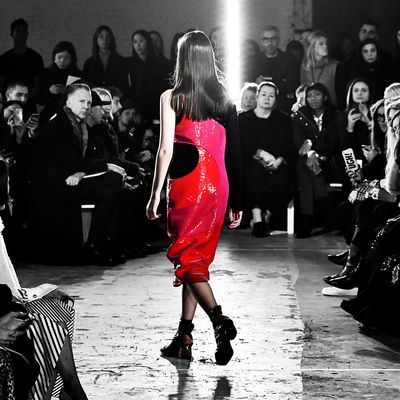
Before this fashion week, while on some heavy drugs — I had just been forcibly separated from my wisdom teeth — I took in Ken Russell’s screen adaptation of The Boy Friend. Russell tweaked the stage version, a lightweight parody of a 1920’s revue, transforming it into a series of trippy dream sequences that make La La Land look like High School Musical. (I’ve seen the movie before, otherwise I’d assume that was just the codeine talking.)
The basic premise: A Hollywood producer sits in a box at a tatty British music hall, watching a cast of amateurs — including Mod icon Twiggy — try to put on the show-within-a-show. But where reality fails, he fills in magic — Busby Berkeley–style numbers and psychedelic reveries where everyone else sees cheap scenery and missed dance steps. The best fashion editors and stylists see fashion in the same way, mentally recasting the seemingly drab into the transcendent. But for most of this New York Fashion Week, the situation felt reversed. Everyone in the audience was lifeless and leaden, most refreshing Twitter like automatons, keeping track of Trump’s latest executive orders. My subway ride back from a show yesterday was entirely given over to discussion of the president’s latest press conference, and I lost count of the amount of times I saw someone next to me raise their phone to take a picture and spotted a terrifying news alert on it. Basically, if I encountered anyone who didn’t seem profoundly morose, I assumed they hadn’t been paying attention.
The truism is that fashion gets more extravagant and more fanciful as the times get darker, and there’s some evidence for that. Depression-era filmgoers thrilled to Adrian’s gowns, and Studio 54 and its glam styles coincided with lean times. Perhaps in keeping with this trope, much of what hit the runway was pure fantasy — with Nouvelle Society gowns that seemed completely uninflected with irony. Confronted with yet another glittering bubble dress or opulent fur, I often felt like I was in 1987, and sometimes I would mentally teleport three decades back only to find myself jarringly in the present. It was like a very advanced form of jet lag.
The runway has always felt disconnected from reality, but this time designers seemed to be fundamentally misreading the public. People don’t seem to want to lose themselves in fantasy right now. Yes, I understand that ultimately, this is about selling clothes, but at the high-fashion level, style is not just about escapism or comfort — it should, like any other art form, react to what’s actually going on.
Certainly, there were many designers who made overt political statements throughout the week. But no one really seemed to be metabolizing the distress of the times in their work. There were slogans on T-shirts and hats and well-intentioned speeches, but few collections that seemed to be working through anger and confusion using fashion as their medium. Shows that didn’t aim for grandeur felt more of the times — like Yeezy, which missed the mark last season, and was refreshingly lower-key this time. (People are really not in the mood for endless wait times and celebrity parades right now.) In a similar vein, Marc Jacobs’s unadorned, social-media-free setting freed us from the distraction of content creation for a blessed six minutes and allowed everyone to focus on the clothes. Soundtracked by complete silence, it felt like 1987 in a good way.
But thus far, there has been no Alexander McQueen–like figure who has channeled everyone’s collective frustration into a fiery statement on the runway. Everyone seems to be proceeding with commerce as usual. Will someone tell them that we left “usual” behind three months ago?




